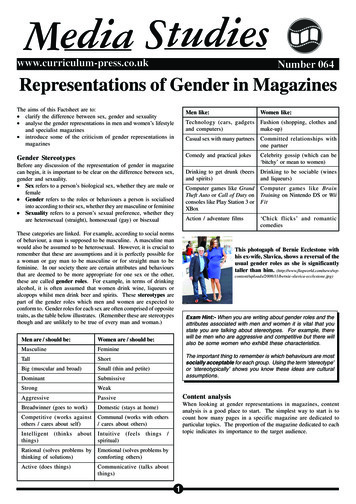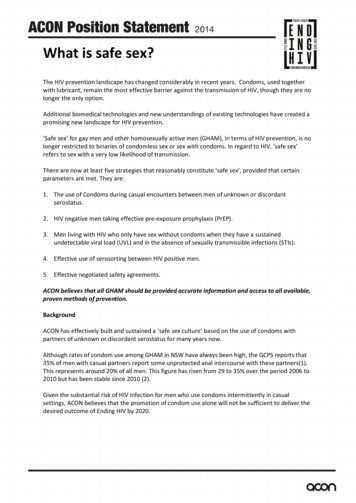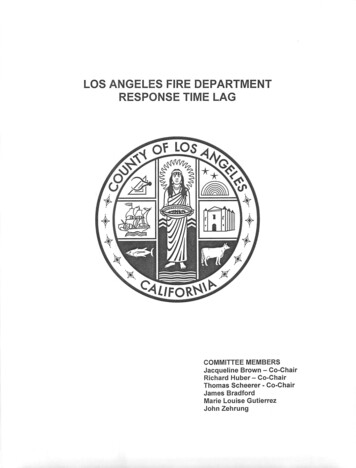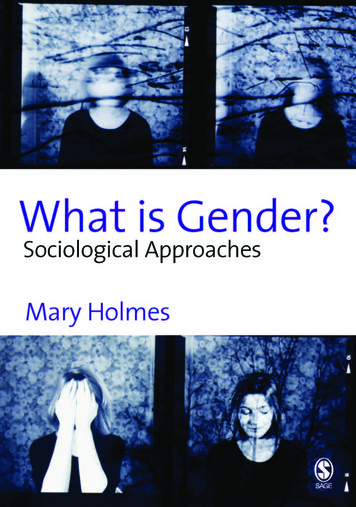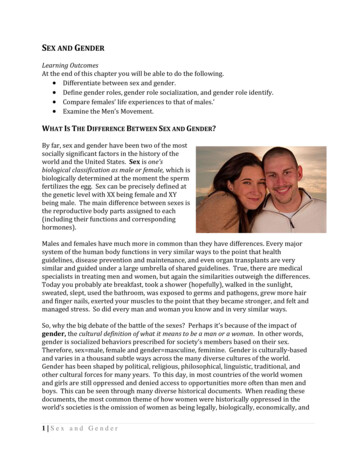
Transcription
SEX AND GENDERLearning OutcomesAt the end of this chapter you will be able to do the following.Differentiate between sex and gender.Define gender roles, gender role socialization, and gender role identify.Compare females’ life experiences to that of males.’Examine the Men’s Movement.WHAT IS THE DIFFERENCE BETWEEN SEX AND GENDER?By far, sex and gender have been two of the mostsocially significant factors in the history of theworld and the United States. Sex is one’sbiological classification as male or female, which isbiologically determined at the moment the spermfertilizes the egg. Sex can be precisely defined atthe genetic level with XX being female and XYbeing male. The main difference between sexes isthe reproductive body parts assigned to each(including their functions and correspondinghormones).Males and females have much more in common than they have differences. Every majorsystem of the human body functions in very similar ways to the point that healthguidelines, disease prevention and maintenance, and even organ transplants are verysimilar and guided under a large umbrella of shared guidelines. True, there are medicalspecialists in treating men and women, but again the similarities outweigh the differences.Today you probably ate breakfast, took a shower (hopefully), walked in the sunlight,sweated, slept, used the bathroom, was exposed to germs and pathogens, grew more hairand finger nails, exerted your muscles to the point that they became stronger, and felt andmanaged stress. So did every man and woman you know and in very similar ways.So, why the big debate of the battle of the sexes? Perhaps it’s because of the impact ofgender, the cultural definition of what it means to be a man or a woman. In other words,gender is socialized behaviors prescribed for society’s members based on their sex.Therefore, sex male, female and gender masculine, feminine. Gender is culturally-basedand varies in a thousand subtle ways across the many diverse cultures of the world.Gender has been shaped by political, religious, philosophical, linguistic, traditional, andother cultural forces for many years. To this day, in most countries of the world womenand girls are still oppressed and denied access to opportunities more often than men andboys. This can be seen through many diverse historical documents. When reading thesedocuments, the most common theme of how women were historically oppressed in theworld’s societies is the omission of women as being legally, biologically, economically, and1 Sex and Gender
even spiritually on par with men. The second most common theme is the assumption thatwomen were somehow broken versions of men or lesser beings than men.1Biology has disproven the belief that women are broken versions of men. In fact, the 23rdchromosome looks like XX in females and XY in males and the Y looks more like an X with amissing leg than a Y. Ironically, science has shown that males are broken or variantversions of females and the more X traits males have the better their health and longevity.DEBUNKING MYTHS ABOUT WOMENMYTH #1: WOMEN’S REPRODUCTIVE CYCLES IMPAIR THEIR ABILITIES.Since history assumed that women wereimpaired because of their reproductive roles,societies have defined much of thesereproductive traits as hindrances toactivities. In an old home health guide fromthe late 19th century (Patton, 1898), thecountry’s best physicians had very inaccurateinformation and knowledge about the humanbody and how it worked.2Interestingly, pregnancy was considerednormal within most circumstances whilemenstruation was seen as a type of disease process that had to be treated (back then mostphysicians were men and still are today). It refers to menstrual problems as being naturaland normal only if painless.3 Indeed from a male scientific perspective in 1898, femalesand their natural reproductive cycles were problematic.But, to the author, females were more fragile and vulnerable and should be treated morecarefully than males especially during puberty. Patton states, “The fact is that the girl has amuch greater physical and a more intense mental development to accomplish than theboy ” As for public education, he states, “The boy can do it; the girl can—sometimes ” Heattributes most of the female sexual and reproductive problems to public school which is abyproduct of “women’s rights, so called.”He’d probably be stunned to see modern medicine’s discoveries today. In our day, womenare not defined as being inferior in comparison to men. But, in 1898, a physician (thesource of authority in scientific knowledge) had no reservations about stating the culturalnorm in print, that women were considered broken in contrast to men.2 Sex and Gender
MYTH #2: “MY HORMONES MADE ME DO IT.”Males and females produce the same hormones, they just produce them in differentamounts depending on sex. Males secrete more testosterone and females produce moreestrogen. Experiments done on testosterone in the human body have been linked toedginess, competitiveness, and anger—in both males and females. However, hormonelevels fluctuate throughout the day based on environment, activities, and other outsidefactors that may affect moods or feelings (e.g., stress, happiness, anger, elation). Therefore,biology (hormones) is affected by social factors and the socialization process. Thus, themyth that hormones dictate behavior has been debunked. Levels of both estrogen andtestosterone depend on activities and interactions throughout the day. Hormones mayaffect behavior, but they do not control it.Further, testosterone is one of many chemicals interacting in the body that affect humanbehavioral response. Therefore, human behavior is highly governed not by hormones, butby the situation or context in which it occurs. For example, women can be just asaggressive as men when they are either rewarded for that behavior (athletes) or when theythink no one is watching (to avoid social consequences). Research has also shown thatwomen are, in fact, as aggressive as men, but they have been socialized to act out theiraggression in different ways.4The notion that women’s behaviors are dictated by their hormones is an old one. However,women’s hormone levels (especially testosterone) do not fluctuate as much as men’sthroughout the day in response to environmental stimuli. Rather, female hormoneproduction is influenced by the monthly reproductive cycles as well as the cessation of thereproductive capacity (menopause) during the life course. Interestingly, in studies inwhich both men and women participated, men were equally as likely to express moodswings, problems at work, and physical discomfort. This is because men are subject to adaily hormone cycle in which testosterone levels peak at about 4 am and are at their lowestat 8 pm.5“When people say women can’t be trusted because they cycle every month, my response tothat is that men cycle every day, so they should only be allowed to negotiate peace treatiesin the evening.”-- Gorman6GENDER ROLES AS A SOCIAL FORCEGender socialization is the shaping of individual behavior and perceptions in such a waythat the individual conforms to socially prescribed expectations for males and females. Onehas to wonder what might have been different if all women were born into societies thatvalued their uniqueness and similarities in comparison to men. How much further mightcivilizations have progressed?One can better understand the historical oppression of women by considering three socialfactors throughout the world’s history: religion, tradition, and labor-based economic3 Sex and Gender
supply and demand. In almost all of the world’s major religions (Christianity, Islam,Hinduism, Judaism, and many others) very clear distinctions have been made about genderroles, or socialized expectations of what is normal, desirable, acceptable, and conforming formales and females in specific jobs or positions in groups and organizations over the lifecourse. These gender roles have very specific meanings for the daily lives and activities ofmales and females who live under the religious cultures in nations throughout history andeven in our day. The Book of Leviticus in the Judeao-Christian Old Testament has manybiological rituals based specifically on Women’s hygiene. There is no modern-day scientificsupport for these religious rituals on females’ health nor on their reproduction. Thesewere religious codes of conduct, not biologically-based scientifically beneficial codes.Many ancient writings in religions refer to the flaws of females, their reproductivedisadvantages, their temperament, and the rules that should govern them in the religiouscommunity. While many current religious doctrines have transformed as society’s valuesof gender equality have emerged, religion continues to serve as a patriarchal justificationfor sex inequality. Throughout history, religions were a dominant social force in manynations and the religious doctrines, like the cultural values, often placed women in asubjugated role to men at a number of different levels.For example, “And the Lord God said, It is not good that the man should be alone; I willmake a help mate for him. . . . And the rib, which the Lord God had taken from man, madehe a woman, and brought her unto the man.” (Gen. 2:18, 22)This passage presents Eve as an afterthought. Meaning that man (Adam) was the ideal, andwoman (Eve) was created as a “help mate” from the ideal (his rib).“Unto the woman he said, I will greatly multiply thy sorrow and thy conception; in sorrowthou shalt bring forth children; and thy desire shall be thy husband, and he shall rule overthee.” (Gen. 3:16).This passage relates to, how after God made the world a perfect place (Eden), Evedisobeyed God and helped make the world the imperfect place we know. War, pestilence,famine, and every sin were the prices humanity had to pay for Eve’s disobedience. Thebiblical story of creation presents a God-ordained gender-role hierarchy, with man createdin the image of God and woman as a subsequent and secondary act of creation.The second social force is tradition. Traditions can be and have been very harsh towardwomen. Table 1 shows the outcomes of oppression toward women that have and currentlydo exist somewhere in the world. It is remarkable that even though the average womanoutlives the average man by three years worldwide and seven years in developedcountries, there are still a few countries where cultural and social oppression literallytranslates into shorter life expectancies for women.Although pregnancy is not a disease, it carries with it many health risks when governmentsfail to provide resources to expectant mothers before, during, and after delivery of theirbaby. Maternal death is the death of a pregnant woman resulting from pregnancy, delivery,4 Sex and Gender
or recovery complications. Maternal deaths number in the hundreds of thousands and areestimated by the United Nations to be around ½ million per year worldwide.7 Typically,very little medical attention is required to prevent infection, mediate complications, andassist in complications to mothers. To answer this problem one must approach it at thelarger social level with government, health care systems, economy, family, and otherinstitutional efforts. The Population Reference Bureau puts a woman’s risk of dying frommaternal causes at one in 92 worldwide with it being as low as 1 in 6,000 in developedcountries and as high as one in 22 for the least developed regions of the world.8 ThePopulation Reference Bureau (PRB) reports “little improvement in maternal mortality indeveloping countries.”9Table 1. Outcomes of the 10 Worse Forms of Oppression of Women-Worst to Least.1010-Death from cultural and social oppression (Various Countries)9-Sexual and other forms of slavery (Western Africa and Thailand)8-Maternal deaths (Sub-Sahara Africa and developing nations)7-Female Genital Mutilation (Mid-Africa about 120 million victims)6-Rape and sexual abuse (South Africa and United States are worst countries)5-Wage disparity (worldwide)4-No/low education for females (various degrees in most countries of the world)3-Denial of access to jobs and careers (many developing nations)2-Mandatory covering of females’ bodies head to toe (Traditional countries, Muslim)1-Public demeaning of women (still practiced, public and private)Female genital mutilation is the traditional cutting, circumcision, and removal of most orall external genitalia of women for the end result of closing off some or part of the vaginauntil such time that the woman is married and cut open. In some traditions, there arereligious underpinnings. In others, there are customs and rituals that have been passeddown. In no way does the main body of any world religion condone or mandate thispractice—many countries where this takes place are predominantly Muslim—yet localtraditions have corrupted the purer form of the religion and its beliefs and female genitalmutilation predates Islam.11There are no medical therapeutic benefits from female genital mutilation. Quite thecontrary, there are many adverse medical consequences that result from it, ranging frompain, difficulty in childbirth, illness, and even death. Many human rights groups, the UnitedNations, scientists, advocates, the United States, the World Health Organization, and otherorganizations have made aggressive efforts to influence the cessation of this practiceworldwide, but progress has come very slowly. Part of the problem is that women oftenperform the ritual and carry on the tradition as it was perpetrated upon them. Femalegenital mutilation (FGM) is often performed in order to preserve the purity of femalesbefore marriage—a cultural ideal in some societies.Rape is another act of oppression toward women. Rape is not the same as sex. Rape isviolence, motivated by men for power. Rape is dangerous and destructive and more likelyto happen in the United States than in most other countries of the world. There are 1955 Sex and Gender
countries in the world today. The U.S. typically is among the worst five percent in terms ofrape. Consecutive studies performed by the United Nations Surveys on Crime Trends andthe Operations of Criminal Justice Systems confirm that South Africa is the most dangerous,crime-ridden nation on the planet in all crimes including rape.12The United Nations reported that, according to World Bank data, women aged 15 to 44 aremore at risk from rape and domestic violence than from cancer, motor accidents, war, andmalaria.13OPPORTUNITIESWage disparities between males and females are both traditional and labor-basedeconomic supply and demand. Statistics show past and current discrepancies in lower payfor women. Diane White, during a 1997 presentation to the United Nations GeneralAssembly, stated that “Today the wage disparity gap cost American women 250,000 overthe course of their lives.”14Indeed evidence supports her claim that women are paid less in comparison to men andtheir cumulative losses add up to staggering figures. The U.S. Census Bureau reported in2008 that U.S. women earn 77 cents for every U.S. man’s 1.15 They also reported that insome places (Washington D.C.) and in certain fields (computer science and mathematical)women earn as much as 98 cents per a man’s 1. At the worldwide level, “as employees,women are still seeking equal pay with men. Closing the gap between women’s and men’spay continues to be a major challenge in most parts of the world.”16The report also discussed the fact that about 60 countries have begun to keep statistics oninformal (unpaid) work by women. Needless to say, even though measuring paid andunpaid work of women is not as accurate as needed for world considerations, “Womencontribute to development not only through remunerated work but also through a greatdeal of non-remunerated work.”17Why the lower wages for women? The traditional definition of the reproductive roles ofwomen as being “broken, diseased, or flawed” is part of the answer of wage disparity. Theidea that reproductive roles interfere with the continuity of the workplace and the idea thatwomen cannot be depended on plays heavily into the maltreatment of women. Theargument can be made that traditional and economic factors have led to the existingpatterns of paying women less for their same education, experience, and efforts comparedto men.Efforts to provide formal education to females worldwide have escalated over the last fewdecades. The 2002 Kids Count International Data Sheet estimated rates as low as 11% offemales in primary school in Somalia. A 1993 World Bank report made it very clear thatfemales throughout the world were being neglected in receiving their formal educationswhen compared to males.186 Sex and Gender
In 1998, another example was found in efforts specific to Africa via the Forum of AfricanWomen Educationalists which focuses on governmental policies and practices for femaleeducation across the continent.19 Literally hundreds of studies have since focused on otherregions around and below the equator where education levels for females are much lower.In 1999, it was reported by UNICEF that one billion people would never learn to read aschildren and 130 million school-aged children (73 million girls) are without access to basiceducation.20 Another UNICEF report clearly identifies the importance of educating girlswho grow up to be mothers because of the tremendous odds that those educated motherswill ensure that their children are also formally educated.21 Somalia is now up to 22% forboys and girls in primary schools, yet in most countries females are still less likely to beeducated.22 The main point from UNICEF and many other formal reports is that higherformal education for females is associated with life, health, protection from crime andsexual exploitation, and countless other benefits, especially to females in the poorerregions of the world.In the United States most females and males attend some form of formal education. Afterhigh school, many go to college. Even though the U.S. numbers of 18 to 24 year old men arehigher than women,23 women are more likely to attend college based on percentages(57%).24A projection from the National Center for Education Statistics projects a continuing trendup and through the year 2016 where about 58% of U.S. college students will be female.25By 2016, about 60% of graduated students will be females.26 These numbers reflect astrong and concerted push toward equality of opportunity for females in formal educationthat dates back over a century. The challenge is to avoid defining progress for U.S. femalesin public and private education as having been made at the expense of males--that’s muchtoo simplistic. They also reflect a change in the culture of bread winning and the adultroles of males. Males and/or females who don’t pursue a college degree will make lessmoney than those who do. To make sense of this trend, many males have been identified ashaving a prolonged adolescence (even into their 30’s), video game playing mentality, and a“Live-with-your-parents-indefinitely” strategy until their shot at the labor force has passedthem by. Others have pointed out the higher rates of learning disabilities in K-12, therelatively low percentage of K-5 teachers who are males, and the higher rate of maledropouts. Still others blame attention deficit and hyperactivity as part of the problem.Here is a truism about education in the U.S.: higher education higher pay higher socialprestige higher quality of life. Many countries of the world have neutralized thetraditional, religious, and labor-force based biases against women and have moved to amerit-based system. Even in the U.S., there have been men wages, and women’s andchildren’s wages (1/10th to 2/3rd of a man’s). In a sense, any hard working, talentedperson can pursue and obtain a high-end job, including women. Communism broke someof these barriers early on in the 20th century, but the relatively low wages afforded thosepursuing these careers somewhat offset the advances women could have made. Progressin the U.S. has come more slowly. Physicians are some of the brightest and best paidspecialists in the world. Salaries tend to begin in the 100,000 range and can easily reach7 Sex and Gender
500,000 depending on the specialty.27 Prior to 1970, most physicians were white andmale, but things are slowly changing. See Table 2 for trends between 1970 and 2006.The upward trend shows a concerted effort to provide equal opportunity for females andmales. Engineers have also seen a concerted effort to increase the number of females in theprofession. The Society of Women Engineers is a non-profit organization which helpssupport and recognize women as engineers.28 Figure 1 shows gains in computer-basedcareers for women. The same cannot be said for doctoral level employment in the moreprestigious fields. Figure 2 presents 2005 estimates from the U.S. National ScienceFoundation. The first 6 fields are the highest paying fields to work in while social andpsychological sciences are among the least paying. Women clearly dominate psychologyand nearly tie in social sciences and biology. True, at the doctoral level pay is higher thanat the masters and bachelors levels, but the difference in engineering and psychology isremarkable at every level of education.29Table 2. The Percentage of Physicians who are Male and Female.30Year %Male 76.374.824.025.22003200674.272.225.827.8The mandatory covering of females’ bodies head to toe has been opposed by some andapplauded by others. Christians, Hindus, and many other religious groups have thepractice of covering or veiling in their histories. Yet, over the last 30 years, asfundamentalist Muslim nations and cultures have returned to their much more traditionalway of life, Hijab which is the Arabic word that means to cover or veil has become morecommon (ħijāb or حجاب ,). Often Hijab means modest and private in the day-to-dayinterpretations of the practice. For some countries it is a personal choice, while for othersit becomes a crime not to comply. The former Taliban punished such a crime with death(they also punished formal schooling of females and the use of makeup by death). Manywomen’s rights groups have brought public attention to this trend, not so much becausethe mandated covering of females is that oppressive, but because the veiling and coveringis symbolic of the religious, traditional, and labor-forced patterns of oppression that havecaused so many problems for women and continue to do so today.8 Sex and Gender
Figure 1. Women in High Tech Jobs.31The public demeaning of women has been acceptable throughout various cultures becausepublicly demeaning members of society who are privately devalued and or consideredflawed fits the reality of most day-to-day interactions. Misogyny is the hatred of womenoften manifested as physical or verbal abuse and oppressive mistreatment of women. Verbalmisogyny is unacceptable in public in most Western Nations today. With the ever presenttechnology found in cell phones, video cameras, and security devices a person’s private andpublic misogynistic language could be easily recorded and posted for millions to see on anynumber of Websites. Perhaps, this fear of being found out as a woman-hater is not the idealmotivation for creating cultural values of respect and even admiration of women and men.As was mentioned above, most of the world historical leaders assumed that women werenot as valuable as men. Women were treated as the totality of their reproductive role, asbreeders of the species, rather than valued human beings they are throughout the worldtoday.9 Sex and Gender
Figure 2. United Doctorates States Conferred By Characteristics of Recipients, 2005.32RESEARCH ON GENDERMargaret Mead’s (1901-1978) work became a major seminal work in the women’sliberation movement and thereby in the redefinition of women in many WesternSocieties.33 Her observations of gender in three tribes: Arapesh, Mundugamor, andTchambuli created a national discussion which lead many to reconsider the establishedsex-gender assumption. In these tribes she found the following:Arapesh: both men and women displayed what we typically call the feminine traitsof sensitivity, cooperation, and low levels of aggression.Mundugamor: both men and women were insensitive, uncooperative, and veryaggressive. These were typical masculine traits at the time.Tchambuli: women were aggressive, rational, and capable and were also sociallydominant. Men were passive, assuming artistic and leisure roles.Why then, Mead argued, if our reproductive roles determined our cultural and socialopportunities, were the gender definitions varied and unique among less civilized peoples?Were we less civilized ourselves at one point in history and have we not progressed on asimilar path the tribal people take? Could it be that tradition (culture) was the strongersocial force rather than biology? Mead’s work and her public influence helped to establishthe belief that biology is only a part of the sex and gender question (albeit an important10 S e x a n d G e n d e r
part). Mead established that sex gender. But, even with the harshest criticism launchedagainst her works, her critics supported and even inadvertently reinforced the idea thatbiology shapes but culture is more salient in how women and men are treated by thosewith power.LanguageProfessional and volunteer organizations have made concerted efforts to raise awarenessof the English language and its demeaning vocabulary toward females. English as aderivative of German has many linguistic biases against women, non-whites, the poor, andnon-royalty. Raising awareness and discussing the assumptions within English or anyother language has been part of the social transformation toward cultural and biologicalfairness and equality. If we understand how the words we use influence the culture we livein and how the value of that culture influences the way we treat one another, then we beginto see the importance of language on the quality of life. Examples: unequal connotations:master—mistress, bachelor—spinster, patron—matron. Generic he/man: policeman,fireman, mankind, workman’s compensation, etc.The Global Gender Gap Index was developed to measure the quality of life for women. Itmeasures the gap between males and females in objective statistics that focus on equality.There are four pillars in the index: economic participation and opportunity, educationalattainment, political empowerment, and health and survival using 14 indicators from eachcountry’s national statistics. From 1998 to 2006, there was a reported net improvementfor all countries.34When one considers the day-to-day lives of women in these international statistics, andperhaps more importantly in their personal lives, the concept of what women do as theircontribution to the function of society becomes important. Instrumental tasks are goaldirected activities which link the family to the surrounding society, geared toward obtainingresources. This includes economic work, bread winning, and other resource-based efforts.Expressive tasks are those that pertain to the creation and maintenance of a set of positive,supportive, emotional relationships within the family unit. This includes relationships,nurturing, and social connections needed in the family and society. Today, women do bothand typically do them well.Prior to the Industrial Revolution, both males and females combined their local economicefforts in homemaking. Most of these efforts were cottage industry-type where familiesused their children’s labor to make products they needed, such as soap, thread, fabric,butter, and many other products. When the factory model of production emerged inWestern Civilizations, the breadwinner and homemaker became more distinct. Abreadwinner is a parent or spouse who earns wages outside of the home and uses them tosupport the family. A homemaker is typically a woman who occupies her life withmothering, housekeeping, and being a wife while depending heavily on the breadwinner.11 S e x a n d G e n d e r
WHAT ABOUT MEN?In the past two decades a social movement referred to as TheMen’s Movement has emerged. The Men’s Movement is abroad effort across societies and the world to improve thequality of life and family-related rights of men.Since the Industrial Revolution, men have been emotionallyexiled from their families and close relationships. They havebecome the human piece of the factory machinery (orcomputer technology in our day) that forced them todisconnect from their most intimate relationships and tobecome money-acquisition units rather than emotionallypowerful pillars of their families.Many in this line of thought attribute higher suicide rates,death rates, accident rates, substance abuse problems, and other challenges in the lives ofmodern men directly to the broad social process of post-industrial breadwinning. Not onlydid the Industrial Revolution’s changes hurt men, but the current masculine role is viewedby many as being oppressive to men, women, and children. Today a man is more likely tokill or be killed, to abuse, and to oppress others. Table 3 lists some of the issues of concernfor those in the Men’s Movement.Table 3. Concerns in the Men’s Movement.1.2.3.4.5.6.7.8.9.10.11.12.Life and health challengesEmotional isolationSexual research and rightsPost-divorce/separation father’s rightsFalse sex or physical abuse allegationsEarly education challenges for boysDeclining college attendanceProtection from domestic abuseMan-hating or bashingLack of support for fatherhoodPaternal rights and abortionAffirmative action-sex and raceThe list of concerns displays quality of life issues mixed in with specific legal and civil rightsconcerns. Men’s Movement sympathizers would most likely promote or support equality ofrights
gender is socialized behaviors prescribed for society’s members based on their sex. Therefore, sex male, female and gender masculine, feminine. Gender is culturally-based and varies in a thousand subtle ways across the many diverse cultures of the world. Gender has been shaped by politica

